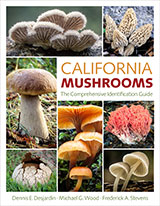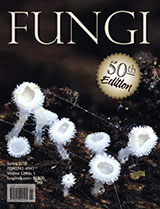Media Review
The Fifth Kingdom
At the outset, I must confess that I have not planted both feet firmly in the digital age. I still take photos on film (although I now have a film scanner to digitize them) and still prefer a book on paper to a computer screen or loose bunch of printed-out pages. Thus, so as not to let that bias overly influence things, this review will focus on the content and presentation rather than the medium, and leave the decision over “paper or plastic” to the reader.
I have long felt that most amateur mushroom enthusiasts are missing out on a great deal of the fascination of fungi because they have had little exposure to the basic biology of our favorite organisms and the myriad ways in which the activities of fungi intersect with our own affairs. But where can the interested toadstool picker find this sort of information in an accessible form? Most general mycology textbooks, with their typically taxonomic-encyclopedic approach, are daunting to lay readers and, although chock full of excellent information, hardly make for entertaining reading even for those with the background to digest their content. Among the general myco-texts available, The Fifth Kingdom has long been the one I’ve recommended for amateurs wanting to learn more about fungal biology and how fungi are important to us. Although still best suited for those with a grasp of basic college-level biology, it is written in an engaging fashion and focuses more on how fungi live and affect us rather than their taxonomy. Its biggest drawback has been the paucity of illustrations and the lack of photographs and color. Kendrick, a retired mycology professor and active NAMA member, has chosen to remedy that situation by producing this third edition of his work in CD-ROM format rather than as a book.
In short, he started with the second paper edition, revised the text, inserted over 1000 color images, and converted it all to CD format. Organization of the text is unchanged, except for the addition of a new chapter on commercial exploitation of fungi. Chapters cover the classification of fungi and fungus-like organisms; descriptions of the major fungal groups; lichens, mycorrhizas, and other fungal symbioses; spore dispersal; physiology, genetics, and ecology; fungal pathogens of plants and humans; and a wide variety of other topics including mycophagy, toxicity, and medical mycology. The overall appearance is basically the same as the book, but in color on a screen. For those familiar with the book and its somewhat “homemade” feel (a result of Kendrick producing the manuscript on his PC), the CD presentation will be familiar -- not the flashy all-the-bells-and-whistles production that you might find in a disk produced by a large commercial publisher.
Some of the more significant changes in this new edition include: a new section on biodiversity, coverage of the frog-killing chytrids, new material on molecular genetics and DNA sequencing, increased coverage of mycorrhizas, discussion of the endophytic fungi of grasses, and of course the large number of new illustrations. The overall presentation remains the same as in the earlier versions -- clear, enthusiastic, and accessible.
Having the added images certainly is a big plus. However, their usefulness could be increased by better integrating them with the text. Most are simply dropped into the text with some added words of explanation. They aren’t numbered, there are few formal captions, and there are no labels within the illustrations to help the reader interpret what she is looking at. Many could stand to be larger for better clarity (I viewed them on a high-resolution 17-inch monitor) and the contrast of the black and white line drawings needs to be increased (they show up as darker gray on paler gray, making some difficult to read). The general quality of the images ranges from excellent to adequate. However, Kendrick is seldom without his digital camera and is always on the lookout for additional or better images to add to the disk.
So, here’s how it works. You’ll need a PC running Windows 95/98/NT (or a Mac with a PC emulator), 32 MB RAM, 200 MHz processor speed, and an 8-MB video card. In most machines, all you have to do is insert the disk into your CD or DVD drive and close the drawer -- after 10 to 30 seconds the program will begin to run on its own. Your internet browser will be loaded (Microsoft Internet Explorer is highly recommended by the author) and the initial screen will provide you with two choices -- The Fifth Kingdom or MatchMaker (described below). Clicking on The Fifth Kingdom will call up the table of contents, from which you select the chapter in which you’re interested. Each chapter is loaded individually and when you reach the end of a chapter you can either continue to the next or return to the table of contents by clicking the appropriate button. Hotlinks are provided at the beginning of each chapter so that you can go straight to the main chapter subheads. A glossary is included, with hotlinks to its terms from the individual chapters. Unfortunately there is no index, so using the book to look up specific information is cumbersome. You must first go to a chapter and then run a search for the occurrence of the particular term in which you’re interested. That said, I must admit that I’ve always felt that the strength of this book has been for sitting and reading a chapter at a time, not necessarily using it as a reference text.
Included at no extra charge is MatchMaker, a database and synoptic key to Pacific Northwest mushrooms designed and compiled by Ian Gibson of the Pacific Northwest Key Council. In the current version, over 1700 taxa are described, and over 600 are illustrated with over 1100 images from 40 different photographers. Although this is still very much a work-in-progress, it will be useful to those interested in identifying Pacific Northwest mushrooms (although many of the species also extend to other parts of North America) as well as for anyone with a desire to see a large sampling of the fungi indigenous to this part of the world. And, hey, you can’t beat the price for this bonus thanks to the generosity of Ian and the many photographers!
Overall, I think this is a fine source of interesting information for amateur mushroomers and will contribute a lot to the enjoyment of your avocation.
— Review by Steve Trudell, Seattle, WA
— Originally published in The Mycophile 41:5, 2000


